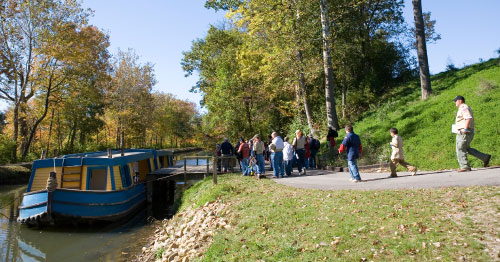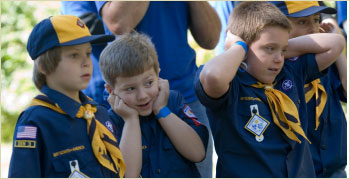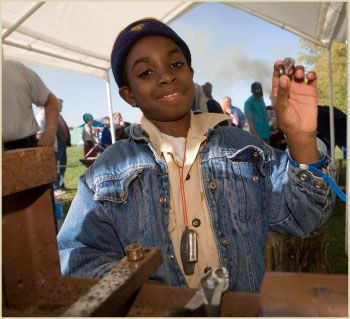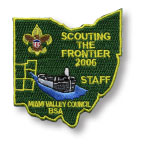Going Back in Time
By Lori Murray
Photographs by Corey Rich
A councilís weekend camporee teaches Ohio Scouts about the lives of pioneers and Indians in the early 1800ís.
 Cub Scouts prepare to board a canal boat on a restored mile-long secton of the Miami and Erie Canal. |
Early on an October morning, a tent city covered an open field on the grounds of Johnston Farm in Piqua, Ohio, but only the scent of breakfasts recently cooked and consumed lingered over the camp.
The tent inhabitants—Scouts and Venturers from the Miami Valley Council, headquartered in Dayton—had moved to a nearby field, where they were enthusiastically participating in a series of activities designed to help them experience the life of Ohio’s pioneers 200 years ago.
This was the first Miami Valley Council camporee to feature a historical setting and theme—“Scouting the Frontier.”
Some Scouts walked on stilts, while others threw tomahawks at targets or lined up to test their skill at blacksmithing—just a few of the games, crafts, and demonstrations designed to emulate life in historic Ohio.
“The whole idea was to show the kids what it was like back in the early 1800’s in Ohio,” said Jerry Ewing, camporee organizer and Sunwatch District committee member-at-large. “What did the pioneers do, and what did it take to maintain a livelihood in those days?”
The planners accomplished their goal by offering a fun-filled lineup of pioneer and Indian activities for the 1,770 Cub Scouts, Boy Scouts, Venturers, parents, leaders, and staff who attended the weekend event.
The Piqua Historical Area site features the restored farmhouse and barn of John Johnston, who was a government Indian agent from 1812 to 1829; a canal boat and restored mile-long section of the Miami and Erie Canal; and a modern museum that traces the story of the Eastern Woodland Indians of Ohio.
Skills from the past
After the Boy Scout and Venturing units camped on the grounds Friday night, Saturday unfolded into nonstop activity—everything from spear throwing to pioneer cooking and black-powder demonstrations.
 At the blackpowder target range, Cub Scouts Riley Dunn, Owen Thomas, and Huntley Schneider, of West Carrolton, Ohio, cover their ears in anticipation of the blast of a vintage muzzle loader. |
Many leaders and demonstrators dressed in period clothing.
At the blacksmithing station, Scouts learned basic skills and then used them to make either a ring or neckerchief slide.
Assisted by an adult, each participant heated a piece of metal over fire, then, using a wrench, twisted the metal to the desired shape.
“It wasn’t scary to heat it up,” said Andrew Gochenaur, a 7-year-old Cub Scout from Pack 813 in Kettering, Ohio. “I pounded the nail and then put it in a bucket of water, which made it cool because it was really hot at first. Then I twisted it to make a ring.” Using a hammer and a prepared mold, participants pounded an image of a BSA emblem onto their final product.
At another station, various outdoor cooking methods were demonstrated, including baking a turkey inside a trash can. Scouts begged the demonstrators to remove the can lid so they could peek inside.
The cooks’ version of Brunswick stew—meat, potatoes, carrots, celery, onions, green peppers, and green beans—simmered in a kettle over an open fire, while green-and-red-pepper shish kebabs sizzled on another fire.
Throughout the day, the sound of black-powder shooting—from a cannon and the muzzle-loading rifles—could be heard. And at the target range, demonstrators, dressed in clothing from the frontier era, showed off their shooting skills by cutting playing cards pinned to fallen trees.
“We practice skills that were common to your ancestors,” demonstrator Terry Wilkerson explained to the Scouts. While Wilkerson was showing how to shoot a black-powder muzzle loader, his daughter, Terri, demonstrated proper use of the bow and arrow on the archery range.
Pioneer games and fun
Pioneer games and challenges proved to be the most popular activities of the day, evidence that regardless of the era, some activities never fail to attract the attention of boys.
 Justin Matlock, Dayton, Ohio, shows the ring he made in the blacksmith area. |
Scouts played games like pickup sticks, corn hole (a beanbag target-toss game), and horseshoes.
Linda Appledorn, camporee volunteer and Preble District advancement chairman, was in charge of selecting the games. “I went online and researched pioneer games,” she said. “I picked some things I thought the boys would enjoy doing.”
Not surprisingly, tomahawk throwing also was a major attraction throughout the day. Ten-year-old Cub Scout Adam Lute of Pack 45 in Belmont, Ohio, explained the technique: “Use the hand you write with, pull it back, and use the opposite leg to step into the throw. It’s really fun.”
Throwing distance varied with age, and the target was a section of a tree trunk attached to a block of wood and backed by a bale of hay.
At the canal, Scouts boarded the General Harrison of Piqua, a 70-by-14-foot replica of boats used in the 1830’s. Two mules, Jack and Jim, stood by, poised to pull the boat on a brief cruise along the waterway.
“I thought the boat was going to be smaller, but it is actually big,” observed 10-year-old Webelos Scout Robbie Gallman, of Pack 161 in New Lebanon, Ohio.
A guide, sporting a straw hat and suspenders, greeted the Scouts. “You are sitting on [what was] the luxury coach of transportation in the 1830’s,” he explained. “Prior to that, horses and wagons were the main means of transportation.”
After hearing more details about the canal, including the waterway’s impact on the cultural and economic life of the pioneers, the boys could ask questions.
Most queries concerned Jack and Jim—from how the mules got their names to what they ate, to their attitude toward their work.
Cub Scout action
Dave Sword, camporee general chairman and Miami Valley Council Wood Badge coordinator, was pleased that the event succeeded in attracting Cub Scouts as well as Boy Scouts.
“It’s neat to expose the younger kids to something like this,” he said. “It encourages family participation and builds enthusiasm with parents.”
As the day evolved, the Cub Scout area was buzzing with activity.
Nancy Briley, Cubmaster of Pack 107, West Alexandria, Ohio, headed a five-member committee to develop 11 crafts and nine games for the Cub Scouts.
“One of the favorites is shaving a balloon,” she said. “They spread shaving cream on the balloon and then ‘shave’ it off with a craft stick—which represents the straightedge razor that the men used back then.”
The Cub Scouts also made six- to eight-inch-long “talking sticks,” decorated with feathers, bells, and knots. They learned that in an Indian tribal council, a member held the stick when it was his turn to speak.
“Stick making was especially successful because the kids really like to make something they can take home,” said Briley.
Other Cub Scout favorites included sand art, ringtoss, tug-of-war, and, of course, the BB-gun and archery target ranges.
To create a sand-art picture, the boys poured different colors of sand onto glue covering a picture of a turtle. The glue captured the necessary sand, with the excess returned to the jars.
For a simple game of ringtoss, the boys tried to throw plastic rings onto the post of a square, wooden block. Tug-of-war challenges reflected true frontier spontaneity, as packs and other groups were urged to challenge their counterparts to a pulling contest at any time during the day.
Participants could easily jump from a craft to a game if an activity was full. There was no shortage of things to do, from making soap carvings and coonskin caps to participating in sack and three-legged races. It was required that a parent or leader accompany each Cub Scout.
Nancy Briley volunteered all day in the Cub Scout area. “The day went well,” she said. “The kids had a great time and learned some skills that we were able to integrate with history.”
Nine-year-old Evan Duffy of Pack 600, Phillipsburg, Ohio, was busy playing a contemporary version of an Indian game called cup-on-a-stick. “You tie string to [a] pencil and punch a hole in the cup and try to get the cup on the end of the pencil,” he explained, intent on succeeding.
The Venturing units created a pioneer campsite. It was primitive and used no lanterns for light—only a fire.
Lasting impact
Everyone was invited to visit the museum. The artifacts were primarily trade and cultural goods, focusing on the impact of the trading post on the American Indian and European cultures.
“The museum includes information about the lifestyle of people that lived in Ohio at that time—both cultural and economic,” said site manager Andy Hite. “We also have a section of exhibits on the canal era.”
By evening, participants gathered for a jazz-band performance and laser show, a thrilling end to an already eventful day.
The camporee and the performance left a lasting impact on many first-time attendees, including Nicholas Trevethan, 11, a new Webelos Scout from Pack 148 in Centerville, Ohio.
After the camporee, Nicholas’s mother, Rachel Riddiford, wrote this in her thank-you letter: “Our first experience in Cub Scout camping was quite amazing. Nicholas had a fantastic time and says he wants to be a Scout for at least the next five years.”
Pack 148 camping coordinator Donald Hume added, “In my opinion, that’s how you recruit new Cub Scouts!”
Freelance writer Lori Murray lives in Columbus, Ohio.
ON THE WEB: To read about other activities that can give Scouts a hands-on learning experience about our nation's past, go to www.scoutingmagazine.org/search.html and click on "American History."
To Plan a Similar EventPlanning an event such as the Miami Valley Council’s “Scouting the Frontier” camporee is a major task.
Eighteen months prior to the event, Sword began to meet with a five-member core committee; the committee later added additional volunteers and divided into the following subcommittees: Cub Scout Program, Boy Scout/Venturing Program, Administration, Support Services (site development), and Evening Program. Here are some of the committees’ best planning tips:
—L.M. |
September 2007 Table of Contents
Copyright © 2007 by the Boy Scouts of America. All rights thereunder reserved; anything appearing in Scouting magazine or on its Web site may not be reprinted either wholly or in part without written permission. Because of freedom given authors, opinions may not reflect official concurrence.
 Dave Sword, the camporee general chairman (he is a former Scoutmaster and currently Wood Badge coordinator) says the key is finding the right people to staff planning committees for different parts of the camporee.
Dave Sword, the camporee general chairman (he is a former Scoutmaster and currently Wood Badge coordinator) says the key is finding the right people to staff planning committees for different parts of the camporee.